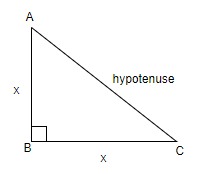Answer
439.5k+ views
Hint: Assume the equal sides of the isosceles triangle as ‘x’. Apply the formula for the area of the triangle given by: $\text{A=}\dfrac{\text{1}}{\text{2}}\text{ }\!\!\times\!\!\text{ base }\!\!\times\!\!\text{ height}$, where ‘A’ is the area of the triangle. Once the side the triangle is determined, apply Pythagoras theorem given by: $hypotenuse=\sqrt{bas{{e}^{2}}+heigh{{t}^{2}}}$, to determine the hypotenuse of the right angle triangle.
Complete step by step answer:
We know that an isosceles triangle has its 2 sides equal. Now, we have been provided with an isosceles right angle triangle. That means its height and base are of the same length.
Let us assume that the height and base of the triangle is ‘x’.

Now, it is given that area of the triangle is 112.5 sq. cm. Therefore, applying the formula of the area of the right angle triangle, we get,
$\begin{align}
& \text{Area=}\dfrac{\text{1}}{\text{2}}\text{ }\!\!\times\!\!\text{ base }\!\!\times\!\!\text{ height} \\
& \Rightarrow 112.5=\dfrac{1}{2}\times x\times x \\
& \Rightarrow {{x}^{2}}=2\times 112.5 \\
& \Rightarrow {{x}^{2}}=225 \\
\end{align}$
Taking square root both sides, we get,
$\begin{align}
& x=\sqrt{225} \\
& \Rightarrow x=15\text{ cm} \\
\end{align}$
Therefore, the length of the base and height of the triangle is 15 cm.
Now, using Pythagoras theorem in the triangle, we get,
$\begin{align}
& \text{hypotenuse}=\sqrt{\text{bas}{{\text{e}}^{\text{2}}}\text{+heigh}{{\text{t}}^{\text{2}}}} \\
& \Rightarrow \text{hypotenuse}=\sqrt{{{x}^{2}}+{{x}^{2}}}=\sqrt{{{15}^{2}}+{{15}^{2}}} \\
& \Rightarrow \text{hypotenuse}=\sqrt{2\times {{15}^{2}}}=15\sqrt{2} \\
\end{align}$
So, the correct answer is “Option b”.
Note: One may note that we do not have to use heron’s formula for the calculation of area in the above question. Although we will get the answer by using heron’s formula here but the process will be very lengthy and also calculation will be hard. So, whenever we have been provided with a right angle triangle then use the normal formula for the calculation of area.
Complete step by step answer:
We know that an isosceles triangle has its 2 sides equal. Now, we have been provided with an isosceles right angle triangle. That means its height and base are of the same length.
Let us assume that the height and base of the triangle is ‘x’.

Now, it is given that area of the triangle is 112.5 sq. cm. Therefore, applying the formula of the area of the right angle triangle, we get,
$\begin{align}
& \text{Area=}\dfrac{\text{1}}{\text{2}}\text{ }\!\!\times\!\!\text{ base }\!\!\times\!\!\text{ height} \\
& \Rightarrow 112.5=\dfrac{1}{2}\times x\times x \\
& \Rightarrow {{x}^{2}}=2\times 112.5 \\
& \Rightarrow {{x}^{2}}=225 \\
\end{align}$
Taking square root both sides, we get,
$\begin{align}
& x=\sqrt{225} \\
& \Rightarrow x=15\text{ cm} \\
\end{align}$
Therefore, the length of the base and height of the triangle is 15 cm.
Now, using Pythagoras theorem in the triangle, we get,
$\begin{align}
& \text{hypotenuse}=\sqrt{\text{bas}{{\text{e}}^{\text{2}}}\text{+heigh}{{\text{t}}^{\text{2}}}} \\
& \Rightarrow \text{hypotenuse}=\sqrt{{{x}^{2}}+{{x}^{2}}}=\sqrt{{{15}^{2}}+{{15}^{2}}} \\
& \Rightarrow \text{hypotenuse}=\sqrt{2\times {{15}^{2}}}=15\sqrt{2} \\
\end{align}$
So, the correct answer is “Option b”.
Note: One may note that we do not have to use heron’s formula for the calculation of area in the above question. Although we will get the answer by using heron’s formula here but the process will be very lengthy and also calculation will be hard. So, whenever we have been provided with a right angle triangle then use the normal formula for the calculation of area.
Recently Updated Pages
Mark and label the given geoinformation on the outline class 11 social science CBSE

When people say No pun intended what does that mea class 8 english CBSE

Name the states which share their boundary with Indias class 9 social science CBSE

Give an account of the Northern Plains of India class 9 social science CBSE

Change the following sentences into negative and interrogative class 10 english CBSE

Advantages and disadvantages of science

Trending doubts
Bimbisara was the founder of dynasty A Nanda B Haryanka class 6 social science CBSE

Which are the Top 10 Largest Countries of the World?

Difference between Prokaryotic cell and Eukaryotic class 11 biology CBSE

Differentiate between homogeneous and heterogeneous class 12 chemistry CBSE

10 examples of evaporation in daily life with explanations

Fill the blanks with the suitable prepositions 1 The class 9 english CBSE

Give 10 examples for herbs , shrubs , climbers , creepers

How do you graph the function fx 4x class 9 maths CBSE

Difference Between Plant Cell and Animal Cell



